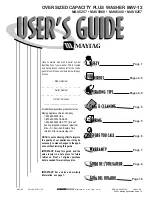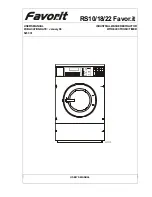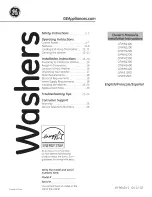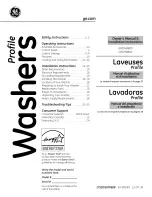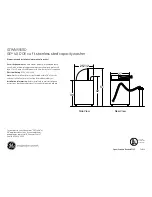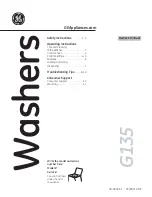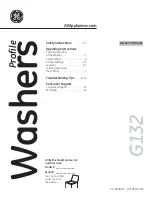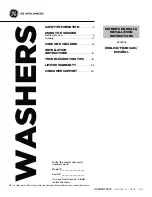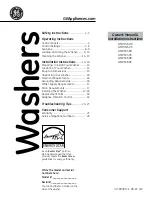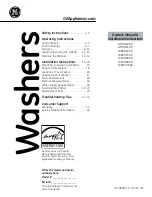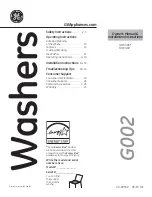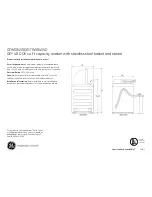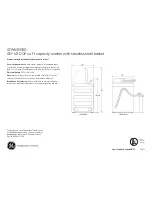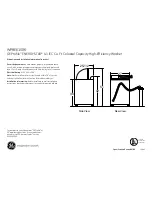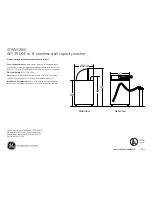
7
6.
Turn the TEMPERATURE selector to the correct setting for the
type of fabric and soils being washed. Use the warmest water
safe for fabric. Some models have an electronic sensor
control that maintains a uniform water temperature. See
“SENSORSURE
™
Temperature Control.” Follow garment label
instructions.
NOTE:
In wash water temperatures colder than 70ºF
(21ºC), detergents do not dissolve well. Soils can be difficult to
remove. Some fabrics can retain wear wrinkles and have
increased pilling (the formation of small lint-like balls on the
surface of garments).
7.
(OPTIONAL STEP) Some models have an EXTRA RINSE
selector. For an additional rinse and spin at the end of the
Normal wash cycle, set the selector to ON.
8.
(OPTIONAL STEP) Some models have an OPTIONS selector.
This allows you to select an End of Cycle Signal at the end of
any cycle and/or add an Extra Rinse to your Normal wash
cycle only.
■
The End of Cycle Signal is helpful when you are washing
items that should be removed from the washer as soon as
the cycle ends.
■
An Extra Rinse removes additional detergent residue from
heavily soiled or special care items.
Set the OPTIONS selector
■
Set the selector at OFF/OFF if you do not desire an End of
Cycle Signal or an Extra Rinse.
■
Set the selector at OFF/ON for an Extra Rinse only.
■
Set the selector at ON/OFF for an End of Cycle Signal
only.
■
Set the selector at ON/ON for an End of Cycle Signal and
an Extra Rinse.
9.
Push in the Cycle Control knob and turn it clockwise to the
wash cycle you want. Reduce wash time when using a small
load size setting. See “Selecting a Cycle and Time.”
Pull out the Cycle Control knob to start the washer.
To stop or restart your washer
■
To stop the washer at any time, push in the Cycle Control
knob.
■
To restart the washer, close the lid (if open) and pull out
the Cycle Control knob.
Selecting a Cycle and Time
This section describes the available wash cycles and will help
you make the best cycle selections for your wash loads. Each
cycle is designed for different types of fabric and soil levels.
■
The washer pauses briefly throughout each cycle. These
pauses are normal. Refer to “Normal Washer Sounds” to
learn more about the sounds you may hear during a wash
cycle.
■
Refer to “Understanding Washer Cycles” to learn what
happens during a wash cycle.
NOTE:
This manual covers several different models. The Cycle
Control knob for each model is shown below. Once you find your
model number, use the cycle descriptions for that particular
washer.
Model KAWS700J
Normal cycle
The Normal cycle features extended agitation time for cleaning
cottons and linens, and longer spin times to shorten drying time.
Select 6, 10, or 12 minutes of wash time, depending on whether
your load is lightly, moderately or heavily soiled.
Extra Wash -
Select the 16-minute Extra Wash feature to wash
heavily soiled loads that need maximum soil removal. Use two
times the amount of recommended detergent for this cycle.
Permanent Press cycle
The
Permanent Press cycle starts with high agitation and then steps to
low for cleaning permanent press blends and synthetic fabrics. To
maximize water removal but minimize wrinkling, this cycle features a
cool-down rinse and a final spin that steps through extra low, low and
high spin. Select 6 or 10 minutes of wash time for lightly to moderately
soiled loads.
Delicate cycle
The 6-minute Delicate cycle can be used to gently clean delicate
items and washable knits. This cycle offers low agitation and spin
speeds.
To use this cycle
1.
Turn the Cycle Control knob to DELICATE/
HANDWASHABLES.
2.
Set the HANDWASH selector to OFF.
Handwashables cycle
The 6-minute Handwashables cycle features brief periods of low
speed agitation and soak time. Low spin speed reduces
wrinkling. Use this cycle for cleaning lightly soiled hand
washables.
To use this cycle
1.
Turn the Cycle Control knob to DELICATE/
HANDWASHABLES.
2.
Set the HANDWASH selector to ON.
Water Temp
Use For
Hot
111°F (44°C)
or above
Whites and pastels
Heavy and greasy soils
Warm
90°-110°F
(32°-43°C)
Bright colors
Moderate to light soils
Cold
70°-90°F
(21°-32°C)
Colors that bleed or fade
Light soils
















